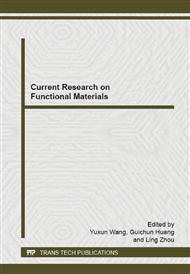[1]
Bai Y., Mu C. P., Zhou X., et al. Influence of percutaneous coronary intervention on blood levels of sICAM-1 and MMPs-9. Chinese Journal of Trauma and Disability Medicine, 2009, Vol. 17, No. 6: 17-19.
Google Scholar
[2]
Li, Q. L.; Chen, J. L.; Chen, C.; Chen, Z. Y.; Chen, J. Y.; Huang, N., Collagen/heparin coating on titanium surface improves the biocompatibility of titanium applied as a blood-contacting biomaterial. J Biomed Mater Res A 2010, 95A (2), 341-349.
DOI: 10.1002/jbm.a.32847
Google Scholar
[3]
Luo C.F., Zheng Y.M. et al., Review: Research Progress and Future Prospects for Promoting Endothelialization on Endovascular Stents an Preventing Restenosis. Journal of Medical and Biological Engineering, 2011, 31(5): 307-316.
Google Scholar
[4]
Wu X, Wang G.X., et al. Mesenchymal Stem Cell Seeding Promotes Reendothelialization of the Endovascular Stent. Journal of Biomedical Materials Research: Part A. 2011, 25(3): 233-242.
DOI: 10.1002/jbm.a.33133
Google Scholar
[5]
Meng, S., et al., The effect of a layer-by-layer chitosan-heparin coating on the endothelialization and coagulation properties of a coronary stent system. Biomaterials, 2009. 30(12): 2276-83.
DOI: 10.1016/j.biomaterials.2008.12.075
Google Scholar
[6]
Liu, Q., X.N. Cheng, and H.X. Fei, Effects of micro-magnetic field at the surface of 316L and NiTi alloy on blood compatibility. Med Biol Eng Comput, 2011. 49(3): 359-64.
DOI: 10.1007/s11517-010-0685-z
Google Scholar
[7]
Pertile, L.B., et al., In vivo human electrochemical properties of a NiTi-based alloy (Nitinol) used for minimally invasive implants. Journal of Biomedical Materials Research Part A, 2009. 89(4): 1072-8.
Google Scholar
[8]
Jiang T, Wang G.X. et al., Preparation and Biocompatibility of Polyvinyl alcohol – Small Intestinal Submucosa Hydrogel Membranes. Journal of Medical and Biological Engineering. 2009, 29(2): 102-107.
Google Scholar
[9]
Zhao, T., et al., Hemocompatibility investigation of the NiTi alloy implanted with tantalum. J Mater Sci Mater Med, 2011. 22(10): 2311-8.
DOI: 10.1007/s10856-011-4406-4
Google Scholar
[10]
Haidopoulos M, Turgeon S, Sarra-Bournet C, et al. Development of an optimized electrochemical process for subsequent coating of 316 stainless steel for stent applications. J Mater Sci Mater Med 2006; 17(7): 647-657.
DOI: 10.1007/s10856-006-9228-4
Google Scholar
[11]
X. N. Gu, Y.F. Zheng, Y. Cheng, S. P. Zhong, T. F. Xi, Biomaterials 30 (2009): 484-498.
Google Scholar
[12]
Z. J. Li, X. N. Gu, S. Q. Lou, Y. F. Zheng, Biomaterials 29 (2008): 1329-1344.
Google Scholar
[13]
Guixue Wang, Shuping Ge, Yang Shen, Honggang Wang. Study on the biodegradability and biocompatibility of WE magnesium alloys. Materials Science and Engineering C 32 (2012): 2190–2198.
DOI: 10.1016/j.msec.2012.05.050
Google Scholar
[14]
H. G. Wang, T. Y. Yin, S. P. Ge, etc. Biofunctionalization of titanium surface with multilayer films modified by heparin-VEGF-fibronectin complex to improve endothelial cell proliferation and blood compatibility. J Biomed Mater Res Part A 2012: 00A.
DOI: 10.1002/jbm.a.34339
Google Scholar


